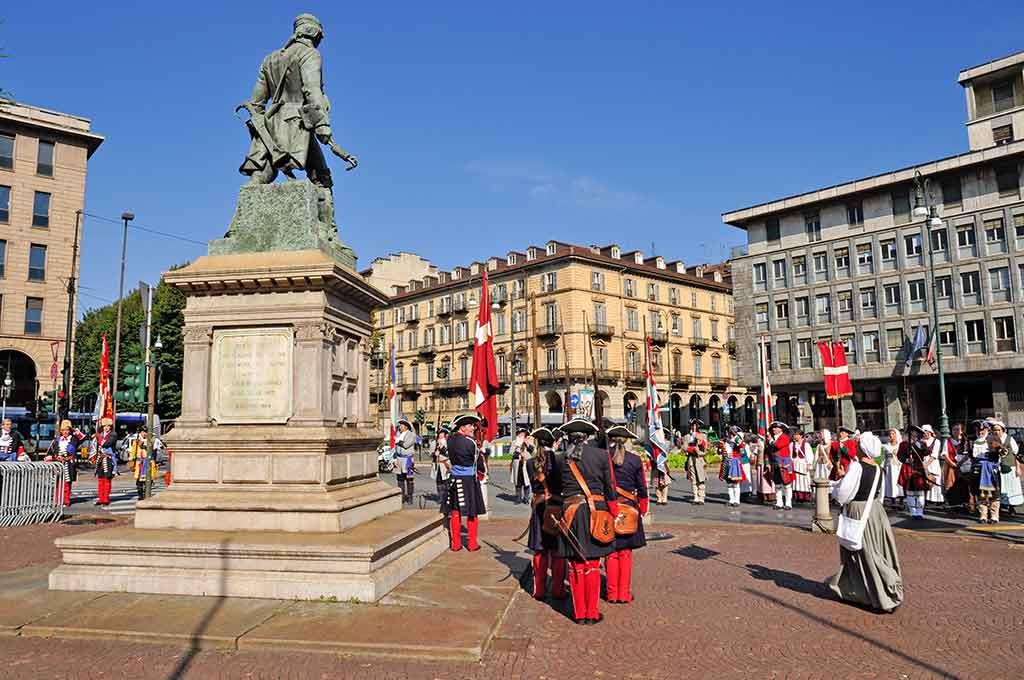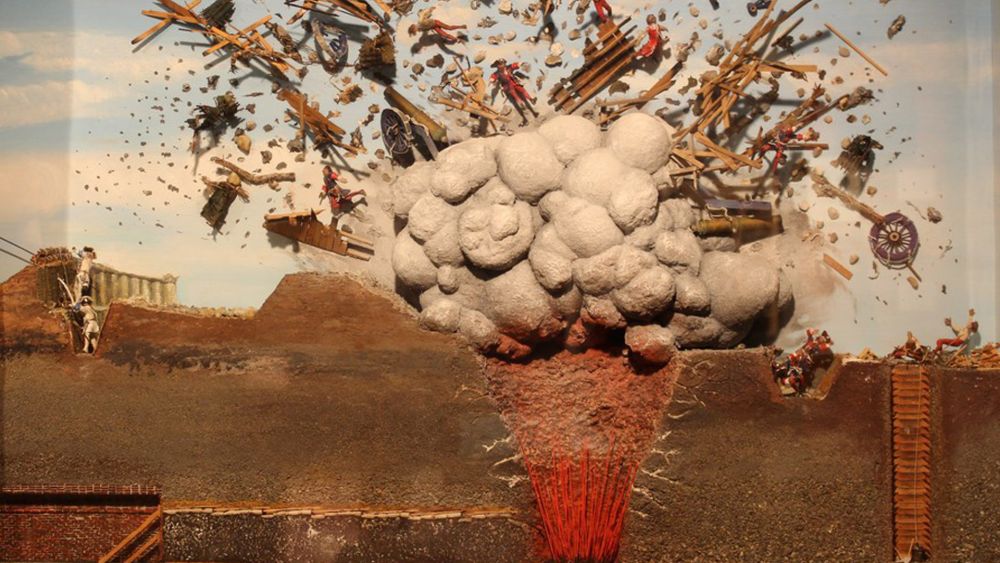The Museo Pietro Micca e dell’Assedio di Torino del 1706, in English Pietro Micca and the Siege of Turin Museum of 1706, is a popular attraction for tourists and Turin residents. Dedicated to Pietro Micca, the brave Piedmontese soldier who sacrificed himself to save the city, the museum retraces the story of the siege of Turin during the War of the Spanish Succession. However, what makes this museum special are the underground galleries of the Citadel, remained largely intact since the siege.
Table of Contents
The Citadel of Turin and its historical role
The Citadel of Turin, a historic pentagonal fortress, stands in the heart of the city centre. Commissioned by Duke Emanuele Filiberto of Savoy and constructed between 1564 and 1570, its purpose was to fortify Turin’s defenses. Its construction followed the relocation of the Duchy’s capital from Chambéry to Turin.
PLAN YOUR TRIP TO TURIN
Purchase the Torino + Piemonte Card online to enjoy free public transportation in Turin, as well as access to museums, castles, fortresses, and royal residences in Turin and the Piedmont region.
While travelling in Italy, you can stay connected with family and friends using the Holafly eSIM, which offers unlimited data at 3G, 4G, and LTE speeds. Additionally, be sure to get Heymondo travel insurance for a worry-free adventure.
This fortress is famous for its key role in the siege of 1706, when attacked by the Franco-Spanish troops of Louis XIV during the War of the Spanish Succession. Much of the ancient walls and bastions have been lost over time. The Mastio, the entrance building, however, has remained intact and today houses the National Artillery History Museum.
During the Napoleonic occupation of Turin between 1800 and 1814, numerous city fortifications were demolished. The Mastio was spared because of its historical and architectural importance. Embarking on a visit to the Pietro Micca Museum will not only lead you beneath the Mastio but also unveil additional secrets of this captivating fortress.
The Siege of Turin in 1706
The War of the Spanish Succession was triggered by the heirless death of King Charles II of Spain. It pitted the Frenchman Philip of Anjou, grandson of the Sun King Louis XIV, against the Archduke Charles, younger son of the Austrian Emperor. However, the Duke of Savoy Victor Amadeus II, ruler of Turin, was involved too, despite not competing for the throne. Because of his alliance with the Austrians, the French army attacked the small Savoy duchy.
In 1706, the French besieged Turin with 45,000 soldiers, aiming to overcome the defences of the Cittadella, a fortification surrounded by walls and moats. To the French bombardment, the Turinese responded with a war of mines, resisting until the arrival of the Austrian allies. Thanks to the 21-km-long network of tunnels, 14 km of which were under the Citadel and 7 km facing the surrounding countryside, the Turinese managed to cause numerous losses to the French.
About Pietro Micca: the heroic Piedmontese soldier
On the night of 29-30 August 1706, the French tried to infiltrate one of the underground tunnels. On this occasion, Pietro Micca, a miner from Biella, distinguished himself for his key role in saving the Citadel. To prevent the French from entering the fortress, he blew up the powder. However, he was hit hard by the explosion, possibly due to a fuse that was too short. His body was found forty paces away.
Pietro Micca’s fame only emerged later, during the Risorgimento, raised as a symbol of the ideal Savoy soldier: faithful, modest and brave. In 1864, a marble statue was erected in his honour in front of the small gardens of the Mastio. It is located in Corso Galileo Ferraris on the corner of Via Cernaia and is the work of sculptor Giuseppe Cassano.

What to see at the Pietro Micca Museum in Turin
The Museo Pietro Micca e dell’Assedio di Torino del 1706 is a unique historical site. The museum entrance is located right where one of the enemy batteries was positioned during the siege. Divided into thematic sections, the museum will guide you through the siege of the city, its protagonists and the recovery activity of the underground structures in recent decades.
The tour takes place on two levels, above and below ground, and offers a partial view of the system of underground countermeasure tunnels. The underground tunnels stretching for kilometres under the city are probably the museum’s main attraction and an exciting experience.
Your visit becomes truly unique thanks to the passionate volunteer guides who accompany you. As you explore, you’ll have the opportunity to touch the brick kerbs that Piedmontese soldiers once used for orientation. Witness the remnants of the staircase that Pietro Micca strategically destroyed to impede the advance of French soldiers.
The Citadel Tunnels and the Mine War
During the visit you will also see a small exterior part of the Citadel of Turin and its ancient walls, entering the large moat that surrounded it. The part of the visit in the galleries allows you to discover the two levels of this defensive structure: the high and low capitals. The high capital tunnels were connected by a magisterial gallery. From these branched off counter-mine branches, small underground tunnels were dug under unsuspecting French troops to hit them with explosions from below.
Mine warfare worked in this way. At the end of each counter-mine tunnel was a room called the ‘cooker’, where barrels of gunpowder were placed. The tunnel was then sealed with earth, allowing only a long fuse to pass through a special conduit so that the fuse could be ignited at a distance and the gunpowder exploded. This caused a powerful explosion upwards where the unsuspecting French troops were standing.
Today, some of the underground tunnels are interrupted by the foundations of houses built in later centuries. However, I assure you that the tour and the history of the siege of 1706 is really interesting.

Helpful information for visiting the Pietro Micca Museum
You can visit the exposition of the Pietro Micca Museum and the Siege of Turin of 1706 without reservation. To visit the counter galleries, on the other hand, you need a reservation. There is in fact a maximum of 15 visitors who can enter at the same time, strictly accompanied by museum staff.
The visitor route is not fully accessible. Its three levels are connected by stairs, some underground spaces are restricted and the flooring in the galleries is uneven. For this reason, the underground route of the counter galleries may not be suitable for people with mobility difficulties or who suffer from claustrophobia. However, virtual tour devices are available to allow anyone to experience the experience in an alternative way.
If you have booked a visit to the galleries, I suggest comfortable clothes and sports shoes, considering the dampness of the underground environment. You can visit the museum with children. If they are really young you can use a sling or baby carrier because you cannot go down into the galleries with a pram.
Museo Pietro Micca e dell’Assedio di Torino del 1706
Via Guicciardini, 7/A
10121 Torino
Where to sleep in Turin
In Turin you can sleep either in elegant hotels located in historical buildings or in modern flats with all comforts, the choice depends only on your taste. Since I live in Turin I can recommend the best hotels, which are the Best Western Plus Executive Hotel and Suites and the luxurious Hotel Principi di Piemonte, both in the city centre. If you are looking for a cheaper option, in modern hostels that also have private rooms, then Combo or CX Belfiore are for you, both located in vibrant neighbourhoods full of restaurants and nightlife.
The Museo Pietro Micca e dell’Assedio di Torino del 1706 (Pietro Micca and the Siege of Turin Museum of 1706) is truly original and a must-see on an itinerary in the Piedmontese capital. Drop a comments if you already know the heroic story of Pietro Micca and the underground tunnels of the Citadel of Turin.
